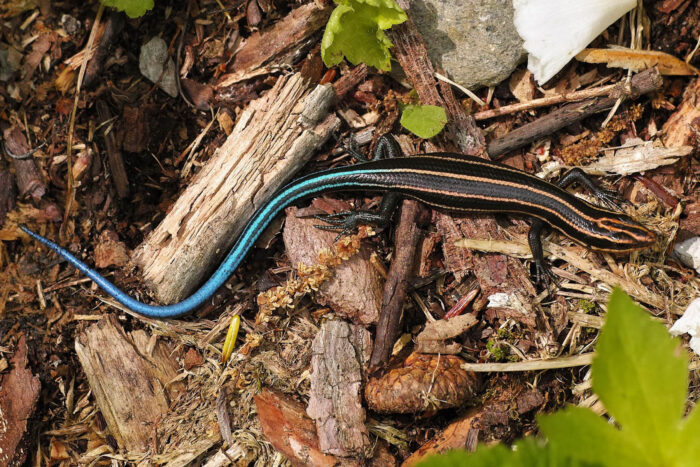Five-lined Skink
Plestiodon fasciatus
The five-lined skink is a small reptile with five distinctive stripes running along the length of its body. It can be found in damp forested areas throughout the Chesapeake Bay watershed.
This section shows one large critter image at a time. Use the thumbnails that follow to select a specific image to display here.

This gallery contains a grid of small thumbnails. Selecting a thumbnail will change the main image in the preceding section.
Appearance
Five-lined skinks are known for the five white or yellow stripes that run down their bodies from nose to tail. The rest of the body can be black, brown or olive. As they age, they tend to lighten and males’ stripes may fade. Juveniles have bright blue tails.
They are between five and 8.5 inches in length. Males have larger heads than females and have orange coloring on their snouts that develop during mating season.
Feeding
Five-lined skinks feed primarily on insects or spiders, but may also eat snails or frogs.
Predators
A variety of birds, snakes, and many small mammals, including domestic cats eat five-lined skinks. The five-lined skink is able to disconnect its colorful tail, which continues to twitch and distract any predators while the skink runs away to hide. The tail will eventually regrow.
Reproduction and life cycle
A male skink will find a partner and clamp his mouth around her neck before mating. Skinks tend to choose large decaying logs or stumps in moist areas for their nests. Often, they will place many nests close together. This allows females to communally care for and defend the eggs.
Females lay about 15 eggs between May and July. The eggs have thin, papery shells and are about half an inch long. They start out white and become more mottled and larger as they stay in contact with the nest and absorb water. The incubation period depends on the temperature—in warmer weather, it can be as short as 24 days. In colder weather, the eggs may incubate for nearly two months.
The young leave the nest after only a couple of days, at which point their parents no longer provide for them. They reach sexual maturity at two or three years of age.
Did you know?
- Five-lined skinks look very similar to their cousins, broad-headed skinks, and must be examined up close to determine the species. Broad-headed skinks have an enlarged row of scales under their tails and five labial scales along their upper lip (between their nose and eye). Five-lined skinks have four labial scales. These species can bite, so only those with experience should attempt to get close enough to count them.
- Skinks are active during the day and are solitary outside of mating season. During the winter months, they hibernate.
- Eggs need to incubate in a humid environment. Females may urinate on the eggs to maintain the necessary level of humidity.
- The scientific genus name, Plestiodon, comes from the Greek language and means “toothy.”
Sources and additional information
- Animal Diversity Web: Plestiodon fasciatus – University of Michigan
- Field Guide to Maryland’s Lizards: Common Five-lined Skink – Maryland Department of Natural Resources
- Common Five-lined Skink – Virginia Herpetological Society
